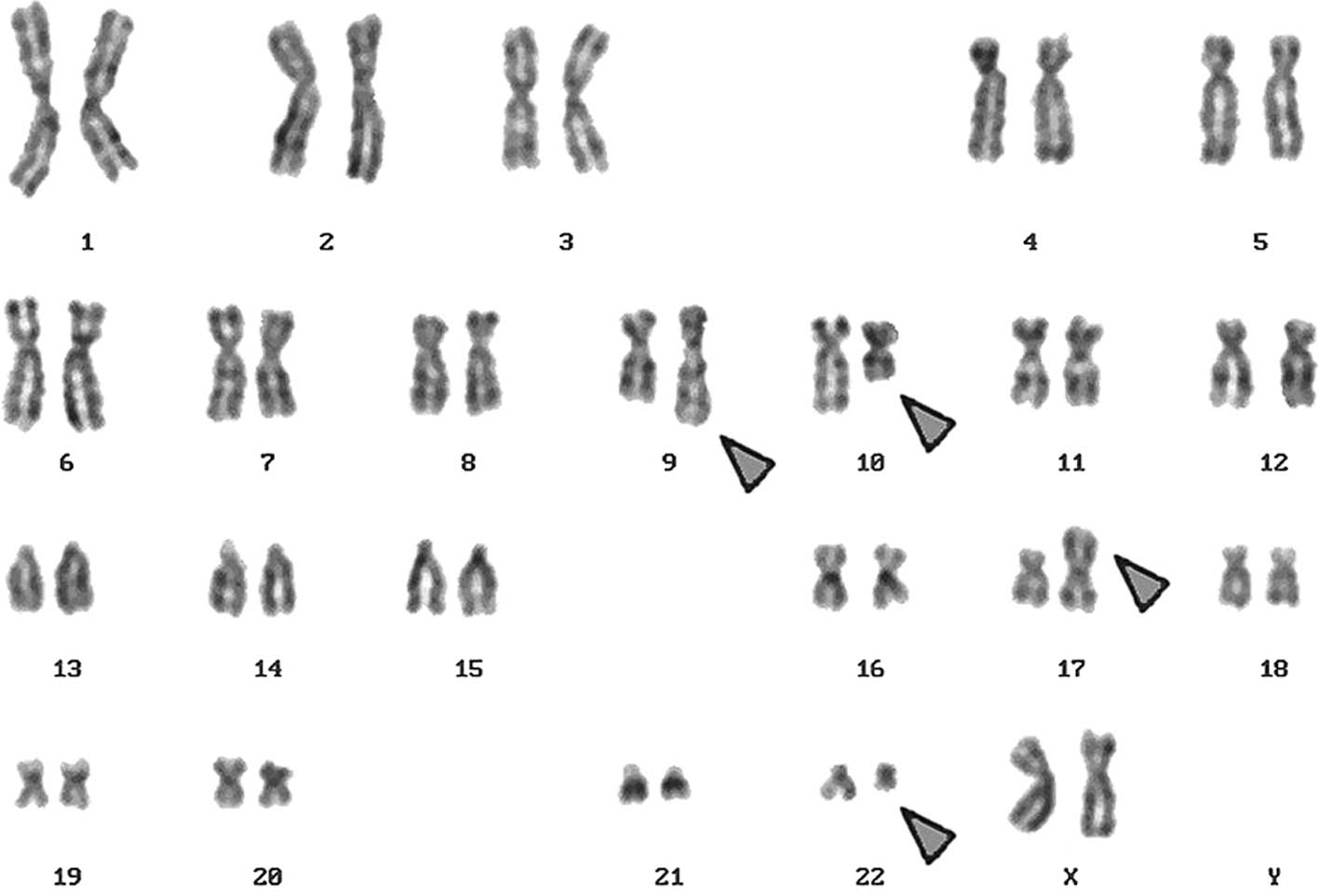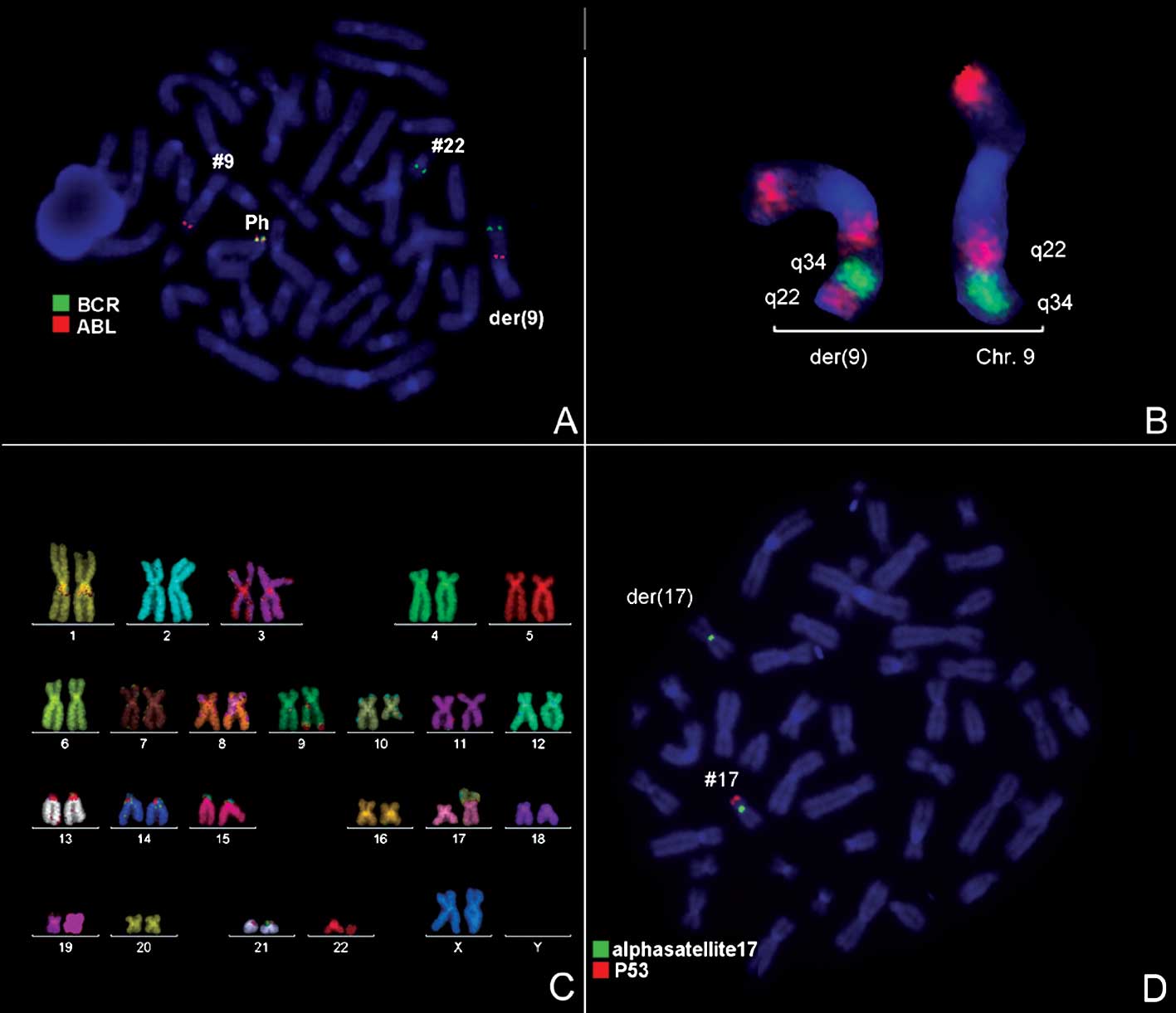A rare case of Philadelphia chromosome-positive chronic myelogenous leukemia with inversion in chromosome 9 and t(10;17)
- Authors:
- Published online on: September 1, 2010 https://doi.org/10.3892/ol_00000138
- Pages: 793-795
Abstract
Introduction
Chronic myeloid leukemia (CML) is a clonal myeloproliferative disorder of pluripotent hematopoieitic stem cells characterized by the BCR and ABL somatic gene rearrangement. In 90–95% of cases with CML, the BCR/ABL fusion gene is the result of the reciprocal translocation between chromosomes 9 and 22, with cytogenetically observable small derivative chromosome 22, which is known as the Philadelphia (Ph) chromosome (1,2). Expression of the BCR/ABL chimeric protein with an increased tyrosine kinase activity plays an essential role in the pathogenesis of CML (3). However, little is known about the corresponding reciprocal translocation product ABL/BCR. The fusion gene ABL/BCR is transcriptionally active in only one-third of CML patients (4). A deletion involving the arginosuccinate synthase (ASS) and ABL genes, located on the derivative chromosome 9, is found in 10–15% of CML patients and is associated with a shortened chronic phase and a decrease in survival in the absence of imatinib treatment (5). Even when deletion of these genes directly leads to loss of ABL/BCR, ABL-BCR expression does not correlate with poor prognosis (6). The progression of CML from the chronic phase (CP) to blast crisis (BC) is frequently associated with non-random secondary chromosomal aberrations, such as +8, i(17q), +19 and an extra Ph (7). At the molecular level, mutation of the tumor suppressor gene TP53 located at 17p13 (8) is detected in 25–30% of CML-myeloid BC. However, no mutation of the remaining TP53 allele in CML cases with i(17q) has been noted (9).
This study examined a rare case of CML with inverted chromosome 9 and unbalanced translocation between chromosomes 10 and 17.
Materials and methods
Case report
A 39-year-old woman was referred to our laboratory in December 2005, due to an occasional blood test showing moderate leukocytosis [the white blood count (WBC) was 113.5×109/l (74% neutrophils, 25% lymphocytes and 1% eosinophils)]. The platelet count was 144.5×109/l and the hemoglobin level was 11.9 g/dl. A physical examination showed splenomegaly. The WBC differential, as well as the bone marrow aspirate, were consistent with CP of CML. The patient had not received any treatment prior to the date of the test. Additionally, patient consent was obtained for this study.
Chromosome analysis
Chromosome analysis using GTG- banding was conducted according to standard procedures (10). A total of 20 metaphases, derived from unstimulated bone marrow of the patient, were analyzed. Karyotypes were described according to the International System for Human Cytogenetic Nomenclature (11).
Fluorescence in situ hybridization analysis
Fluorescence in situ hybridization (FISH) using the LSI BCR/ABL+9q34 Tricolor dual fusion translocation probe (Abbott Molecular/Vysis, USA) and 17p13(p53)/alpha-satellite 17, dual color (Q-Biogene, USA) were applied according to the manufacturer’s instructions. A multicolor banding probe (MCB), based on microdissection-derived region-specific libraries for chromosome 9, was applied as previously described (12,13). A total of 20 metaphase spreads were analyzed, each using a fluorescence microscope (Axio Imager.Z1 mot; Zeiss) equipped with the appropriate filter sets to discriminate between a maximum of five fluorochromes and the counter-stain DAPI (4′,6-diamino-2-phenylindole). Image capturing and processing were carried out using an ISIS imaging system (MetaSystems, Altlussheim, Germany) for the MCB evaluation.
Results
A complex karyotype, 46,XX,t(9;22),t(10;17), was determined in the GTG-banding (Fig. 1) and was further studied by molecular cytogenetics (Fig. 2). Tri-color FISH using a probe specific for BCR, ABL and the ASS gene revealed a typical Ph with the BCR/ABL fusion gene. However, the ASS gene was localized more proximal to the centromere, as 3′BCR was in the terminal part of the derivative chromosome 9 (Fig. 2A). Inversion of 9q22q34 was detected using MCB 9 (Fig. 2B). Thus, M-FISH was applied to confirm the GTG-banding results (Fig. 2C). The locus-specific probe 17p13(p53)/alpha-satellite 17 demonstrated the absence of 17p13 (Fig. 2D). The result obtained was: 46,XX,der(9)t(9;22)(q34;q11)inv(9)(q22q34),der(10)t(10;17)(q22.3;p13.1),der(17)t(10;17)(q22.3;p13.1)del(17)(p13.1),der(22)t(9;22)(q34;q11).
Discussion
The present study identified two additional chromosomal alterations, inv(9)(q22q34) and t(10;17)(q22.3;p13.1)del(17)(p13.1), in Ph+ CML-CP. To our knowledge, the translocation between 10q22.3 and 17p13.1 was previously described in clear-cell sarcoma (2 cases) and endometrial stroma sarcoma (3 cases). Thus, this translocation has never been observed in CML, and the breakpoint 10q22 has been shown to be a partner in the variant translocation t(9;22;V) (14). Although 3′BCR was localized on derivative chromosome 9, the ABL/BCR fusion gene was absent due to inv(9)(q22q34). Therefore, we suggest that the derivative chromosome 9 was formed in a two-event rearrangement. The first step was the reciprocal translocation between chromosome 9 and 22, resulting in subsequent inversion. Reid et al described two CML cases with variant t(9;22;V), where 5′ABL and 3′BCR signals remained present on the long arm of the derivative chromosome 9, but were separated by additional material of a third partner (15). The breakpoint 9q22 was previously shown to be involved in the formation of variant translocation t(9;22;V) in 2 cases with CML (14).
The unbalanced translocation on t(10;17)(q22.3;p13.1) resulted in the loss of a region of the chromosome 17p13.1, including the TP53 gene. During CML progression, isochromosome (17)(q10) is one of the non-random changes. This aberration is associated with loss of the tumor suppressor gene TP53 and mostly with poor prognosis (16). Several relevant genes are affected due to the deletion of 17p and simultaneous formation i(17q). Point mutation and/or deletion of the TP53 gene are regarded as potentially important steps in the development of various hematological malignances (17).
We reported on a novel, unique case of Ph+ CML with a paracentric inversion of the derivative chromosome 9 resulted in the absence of the ABL/BCR fusion gene and the unbalanced translocation of chromosomes 10 and 17 with deletion of the TP53 gene.
Acknowledgements
We thank Dr I. Othman, Director General of the Atomic Energy Commission of Syria (AECS) and Dr N. Mirali, Head of the Molecular Biology and Biotechnology Department for their support. This study was supported by AECS, in part, by the Stefan-Morsch-Stiftung, Monika-Kutzner-Stiftung and the DAAD (D/07/09624).
References
|
Rooney DE: Human Cytogenetics: Malignancy and Acquired Abnormalities. 3rd edition. Oxford University Press; New York: pp. 372001 | |
|
Sessions J: Chronic myeloid leukemia in 2007. Am J Health Syst Pharm. 64:S4–S9. 2007. View Article : Google Scholar : PubMed/NCBI | |
|
Lugo T, Pendergast A, Müller A and Witte O: Tyrosine kinase activity and transformation potency of bcr-abl oncogene products. Science. 247:1079–1082. 1990. View Article : Google Scholar : PubMed/NCBI | |
|
Melo JV, Gordon DE, Cross NC and Goldman JM: The ABL-BCR fusion gene is expressed in chronic myeloid leukaemia. Blood. 81:158–165. 1993.PubMed/NCBI | |
|
Quintas-Cardama A, Kantarjian H, Talpaz M, O’Brien S, Garcia-Manero G, Verstovsek S, Rios M, Hayes K, Glassman A, Bekele B, Zhou X and Cortes J: Imatinib mesylate therapy may overcome the poor prognostic significance of deletions of derivative chromosome 9 in patients with chronic myelogenous leukemia. Blood. 105:2281–2286. 2005. View Article : Google Scholar : PubMed/NCBI | |
|
Melo J, Hochhaus A, Yun X-H and Goldman J: Lack of correlation of ABL/BCR expression and response to interferon-α in chronic myeloid leukaemia. Br J Haematol. 92:684–686. 1996.PubMed/NCBI | |
|
Sandberg AA: The Chromosomes in Human Cancer and Leukemia. 2nd edition. Elsevier Science; New York: pp. 151–172. 1990 | |
|
Rege-Cambrim G, Caidano G, Serra A, Scaravaglio P, Guglielmelli T, Guerrasio A, Giovinazzo B and Saglio G: Analysis of the p53 in myeloid malignancies associated with chromosomal abnormalities involving the short arm of chromosome 17. Leukemia. 8:23–26. 1994.PubMed/NCBI | |
|
Calabretta B and Perrotti D: The biology of CML blast crisis. Blood. 103:4010–4022. 2004. View Article : Google Scholar : PubMed/NCBI | |
|
Claussen U, Michel S, Mühlig P, Westermann M, Grummt UW, Kromeyer-Hauschild K and Liehr T: Demystifying chromosome preparation and the implications for the concept of chromosome condensation during mitosis. Cytogenet Genome Res. 98:136–146. 2002. View Article : Google Scholar : PubMed/NCBI | |
|
Shaffer L, Slovak M and Cambell L: ISCN 2009: An International System for Human Cytogenetic Nomenclature. S. Karger; Basel: 2009 | |
|
Weise A, Mrasek K, Fickelscher I, Claussen U, Cheung SW, Cai WW, Liehr T and Kosyakova N: Molecular definition of high-resolution multicolor banding probes: first within the human DNA sequence anchored FISH banding probe set. J Histochem Cytochem. 56:487–493. 2008. View Article : Google Scholar : PubMed/NCBI | |
|
Liehr T, Heller A, Starke H, Rubtsov N, Trifonov V, Mrasek K, Weise A, Kuechler A and Claussen U: Microdissection based high resolution multicolor banding for all 24 human chromosomes. Int J Mol Med. 9:335–339. 2002.PubMed/NCBI | |
|
Mitelman F, Johansson B and Mertens F: Mitelman Database of Chromosome Aberrations in Cancer. 2009, http://cgap.nci.nih.gov/chromosomes/Mitelman. | |
|
Reid AG, Huntly BJ, Grace C, Green AR and Nacheva EP: Survival implications of molecular heterogeneity in variant Philadelphia-positive chronic myeloid leukaemia. Br J Haematol. 121:419–427. 2003. View Article : Google Scholar : PubMed/NCBI | |
|
Johansson B, Fioretos T and Mitelman F: Cytogenetic and molecular genetic evolution of chronic myeloid leukemia. Acta Haematol. 107:76–94. 2002. View Article : Google Scholar : PubMed/NCBI | |
|
Imamura J, Miyoshi I and Koeffler HP: p53 in hematologic malignancies. Blood. 84:24121994.PubMed/NCBI |











